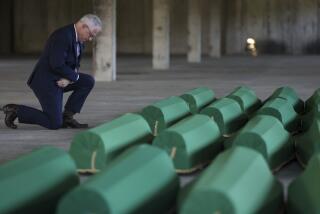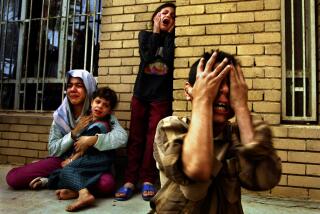Sarajevo’s Lessons for Afghanistan
- Share via
SARAJEVO, Bosnia-Herzegovina — During the war, a secret tunnel ran under this city’s besieged airport and came up in Bajro Kolar’s basement. Every night, some 20 tons of food, arms and medicine flowed through the tunnel into the starving city, while ill and injured people flowed out.
Now, six years after the war’s end, Kolar has turned the tunnel into a private museum. A city map on the basement wall shows Serbian siege lines. The map happens to be the one produced for the 1984 Winter Olympics, with cheerful graphics showing the slalom course and bobsled run. “I use this map to remind people that we once were an Olympic capital and hopefully will be a future one,” says Kolar.
He isn’t the only hopeful man in Sarajevo, a city that offers many lessons in how--and how not--to rebuild a society shattered by civil war. Last December, 25 specialists from the United Nations mission here left for Afghanistan to assess what a similar mission there should look like. They took with them everything from tents to food to experience in trying to reforge a nation out of groups engaged in mutual destruction. Some of the lessons--that peace must be planned for as exactingly as a military campaign, that outside investment needs to be substantial and ongoing and that foreign forces are likely to be needed as peacekeepers for decades--may prove unpalatable to an already stretched international community. Bosnia-Herzegovina remains an international protectorate, with its own political leaders showing little will to move away from sectarian and nationalist positions.
Still, Sarajevo is struggling back into its mantle of tolerant multiculturalism. While shrapnel-pocked walls and ruined buildings remain common here, much has been renewed. An Irish pub offers “20 brands of world beer”; the city’s first sex shop just opened. Down the block, a muezzin calls the faithful to prayer under a fall of fat snowflakes.
The much-shelled Holiday Inn has been reincarnated, bright as a child’s Lego tower, in blocks of vivid yellow. The airport, where passengers used to be warned to sit on their flak jackets for take-off and landing in case of upward-aimed sniper fire, has a smart new terminal. Sycamore and birch saplings line the streets, replacing trees that were cut down for fuel during the cruel winters of the siege. Along the once-perilous airport road, the ruined student-housing complex has been renovated by the United Nations for use as mission headquarters.
That mission is due to begin scaling down this year. In retrospect, says Jacques Paul Klein, the U.N. special representative here, the international community’s biggest mistake was failing to plan adequately for peace. In Germany and Japan, he says, the allies had such a plan. “Here, we assumed if we stopped the violence, that would be enough.” The result: “The war went on bureaucratically, with obfuscation and delay.”
The former U.S. air-force general cites such things as stripping ethnic symbols from car license plates and currency as examples of the small steps that are helping to forge “a single economic and political space.” Bosnia-Herzegovina’s currency is printed with Latin and Cyrillic script in alternating pride of place at the top of each bill. Cars bearing the old license plates, which had identifying national symbols such as the Croatian savonica (checkered shield), Serb cross or Bosnian lily, were often run off the road when they passed through neighborhoods of opposing groups. The new plates use only random numbers and the six letters common to the Latin and Cyrillic alphabets. While Serb leaders had proclaimed that they would sooner eat grass than surrender their symbol, ordinary Serbs, who had had to drive miles out of their way in order to stay on roads within Serb territory, were the swiftest to adopt the new plates.
To create a new flag, Klein set only one design criterion: “That no one had died for it.” He commissioned a panel of academics to come up with three designs, which he promised to present to the parliament. When the first two designs were noisily rejected, Klein declared the third accepted by default. The flag--a yellow triangle representing the shape of the state on a ground of European-Union blue with a diagonal row of stars along one side of the triangle--flies from many buildings in downtown Sarajevo. However, when Klein last visited the Serb leadership in the nearby village of Pale, the flag was stowed in a desk drawer.
There have been practical changes, as well as symbolic ones. The state now has a border patrol and a largely retrained police force. Officers who committed economic or war crimes have been fired. A group of 25 Bosnian Serbs, Croats and Muslims are serving in the U.N. police force in East Timor, while a similarly diverse force of 30 are military observers in Ethiopia and Eritrea. “The leaders said we couldn’t have a mixed force, that they’d shoot each other, but when I told them the per diem was U.S. $110, they rethought that.”
The new calm is held together by a conspicuous NATO-led peacekeeping force. U.S. soldiers in Bosnia-Herzegovina wear battle-dress at all times, even when handing out dreidels and chocolate gelt at a Hanukkah celebration thrown by the city’s small Jewish community. Jacob Finci, a leader of that community, laments that the city’s Jewish museum, closed along with others during the war, still has not been allowed to reopen. “One year after the devastation of World War II, the museums of this city were open,” he says. But now, “No one can agree anymore on how the history should be presented.” At the National Museum, the only open exhibition features Roman antiquities and a prehistoric boat--artifacts that predate the arrival of Serbs, Croats and Muslims.
The museum, which was heavily shelled, remains only partly repaired and has been without heat for nine years. The damp masonry of the interior so magnifies the cold, says the director, Denana Buturovic, that her fax machine has frozen. Instead of the grand director’s office, she has retreated to a tiny room where a space heater makes work bearable if she keeps her hat and coat on. But the museum soon may have at least one comfortable room.
On the top floor of a nearby bank, watched over by museum staff, Sarajevan police and U.N. guards, Andrea Pataki, a book conservator from Stuttgart, is working to stabilize the museum’s chief treasure: a rare illuminated Hebrew manuscript created in 14th-century Spain and somehow spared from Inquisition book burnings. Saved twice by Bosnian Muslim museum staff--once from the Nazis during World War II and again, in 1992, from Serb shelling--the codex spent the recent war hidden in a bank vault. The manuscript has become a symbol of the survival of the city’s multiethnic ideal. Klein is gathering funds from the World Bank and private donors to repair the manuscript’s binding and create a secure, climate-controlled room in which he hopes the Haggada can be displayed, along with related art works such as Serbian Orthodox icons and Islamic miniatures.
As she watches over the restoration, the museum’s assistant director, Mirsada Muskic, has dreams of another way in which the international community could support Sarajevo’s reconstruction. In an act of supreme optimism, the Sarajevans have bid for the 2010 Olympic Winter Games. During the war, the start of the 1984 bobsled run became a notorious sniper pit, while the Olympic archives and museum were torched. “We are poor now,” concedes Muskic, but she somehow hopes the International Olympic Committee might, in a triumph of idealism, overlook that. “We are experts at hope,” she says. “We have to be.”
More to Read
Sign up for Essential California
The most important California stories and recommendations in your inbox every morning.
You may occasionally receive promotional content from the Los Angeles Times.













